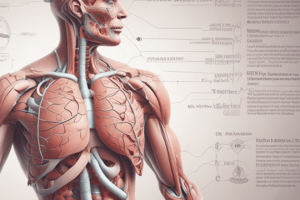Podcast
Questions and Answers
What is the primary function of the respiratory system?
What is the primary function of the respiratory system?
- To regulate body temperature
- To produce energy for the body
- To bring oxygen into the body and remove carbon dioxide (correct)
- To aid in digestion
What is the name of the tube that divides into two bronchi?
What is the name of the tube that divides into two bronchi?
- Pharynx
- Bronchi
- Larynx
- Trachea (correct)
What happens to the diaphragm during inhalation?
What happens to the diaphragm during inhalation?
- It descends
- It stays the same
- It relaxes
- It contracts (correct)
What is the name of the small sacs in the lungs where gas exchange occurs?
What is the name of the small sacs in the lungs where gas exchange occurs?
What is the primary muscle responsible for expanding the lungs during inhalation?
What is the primary muscle responsible for expanding the lungs during inhalation?
What happens to the volume of the chest cavity during exhalation?
What happens to the volume of the chest cavity during exhalation?
What is the role of the intercostal muscles in respiration?
What is the role of the intercostal muscles in respiration?
What is the direction of oxygen diffusion in the lungs?
What is the direction of oxygen diffusion in the lungs?
Flashcards are hidden until you start studying
Study Notes
Overview
- The respiratory system is responsible for bringing oxygen into the body and removing carbon dioxide.
- It is a vital system that allows cells to produce energy and perform their functions.
Components
- Nose and Mouth: Air enters the body through the nose or mouth.
- Trachea: Air passes through the trachea, a tube that divides into two bronchi.
- Bronchi: Bronchi branch into smaller bronchioles, which lead to the lungs.
- Lungs: The lungs are responsible for exchanging oxygen and carbon dioxide through the process of respiration.
- Diaphragm: The diaphragm is a muscle that separates the chest cavity from the abdominal cavity and helps expand the lungs during inhalation.
- Rib Cage: The rib cage protects the lungs and helps expand them during inhalation.
Process of Respiration
- Inhalation:
- Air enters the nose or mouth and passes through the trachea and bronchi.
- The diaphragm contracts and the rib cage expands, increasing the volume of the chest cavity.
- Air enters the lungs, and oxygen diffuses into the bloodstream.
- Exhalation:
- The diaphragm relaxes and the rib cage descends, decreasing the volume of the chest cavity.
- Air is pushed out of the lungs and exits the body through the nose or mouth.
Gas Exchange
- Oxygen: Oxygen diffuses from the air into the bloodstream in the lungs.
- Carbon Dioxide: Carbon dioxide diffuses from the bloodstream into the air in the lungs.
- Alveoli: Alveoli are small sacs in the lungs where gas exchange occurs.
Respiratory Muscles
- Diaphragm: The diaphragm is the primary muscle responsible for expanding the lungs during inhalation.
- Intercostal Muscles: The intercostal muscles are located between the ribs and help expand the chest cavity during inhalation.
- Accessory Muscles: Accessory muscles, such as the neck and back muscles, help with forced inhalation and exhalation.
Regulation of Breathing
- Brainstem: The brainstem regulates breathing through the medulla oblongata and pons.
- Chemoreceptors: Chemoreceptors in the brain and lungs detect changes in oxygen and carbon dioxide levels and send signals to the brainstem to adjust breathing.
- Voluntary Control: The cerebral cortex can also control breathing through voluntary actions, such as holding one's breath.
Respiratory System Overview
- The respiratory system is responsible for bringing oxygen into the body and removing carbon dioxide.
- It's a vital system that allows cells to produce energy and perform their functions.
Components of the Respiratory System
- Nose and Mouth: Air enters the body through the nose or mouth.
- Trachea: A tube that divides into two bronchi.
- Bronchi: Branch into smaller bronchioles, which lead to the lungs.
- Lungs: Responsible for exchanging oxygen and carbon dioxide through the process of respiration.
- Diaphragm: A muscle that separates the chest cavity from the abdominal cavity and helps expand the lungs during inhalation.
- Rib Cage: Protects the lungs and helps expand them during inhalation.
Process of Respiration
Inhalation
- Air enters the nose or mouth and passes through the trachea and bronchi.
- The diaphragm contracts and the rib cage expands, increasing the volume of the chest cavity.
- Air enters the lungs, and oxygen diffuses into the bloodstream.
Exhalation
- The diaphragm relaxes and the rib cage descends, decreasing the volume of the chest cavity.
- Air is pushed out of the lungs and exits the body through the nose or mouth.
Gas Exchange
- Oxygen diffuses from the air into the bloodstream in the lungs.
- Carbon dioxide diffuses from the bloodstream into the air in the lungs.
- Alveoli: Small sacs in the lungs where gas exchange occurs.
Respiratory Muscles
- Diaphragm: Primary muscle responsible for expanding the lungs during inhalation.
- Intercostal Muscles: Located between the ribs and help expand the chest cavity during inhalation.
- Accessory Muscles: Help with forced inhalation and exhalation.
Regulation of Breathing
- Brainstem: Regulates breathing through the medulla oblongata and pons.
- Chemoreceptors: Detect changes in oxygen and carbon dioxide levels and send signals to the brainstem to adjust breathing.
- Voluntary Control: The cerebral cortex can control breathing through voluntary actions, such as holding one's breath.
Studying That Suits You
Use AI to generate personalized quizzes and flashcards to suit your learning preferences.



